Children have an early awareness of number concepts. In infancy, children begin to learn about quantity through interactions with their environment and their caregivers. They begin to demonstrate the understanding of “more” through body language. For example, children may lean their head forward during mealtimes to indicate they want more food. Or, they may use body language and gestures to communicate to a caregiver to repeat an enjoyable action.
Young children are also aware that more than one object exists in their environment. This is indicated when children release one object to reach for another. While they are not able to determine the number of objects, they have established the foundation for the concept of “more.”
Once children have the ability to verbally express themselves, they have the ability to communicate the concept of more. They may sign or say “more” during interactions. Children also use imitation and language to explore number concepts. For example, children may imitate their caregivers and say, “one, two,” when engaged in play. They will not be able to match the correct quantity of objects with their words until closer to 36 months, but use imitation and play skills to build number sense.
Around 24 months of age, children have the ability to identify very small quantities without having to count them. They can look at a small number of objects and determine if there are “one,” “two,” or “three” of them. By 36 months, children use language to demonstrate an understanding of progressive number order and can identify “more” when comparing groups of objects.
‘More’ and ‘Enough’
While quantity and numbers are complex concepts in the school-age period, children build the foundation for these in the first three years. Children begin to experience quantity and numbers through everyday interactions with caregivers. The first mathematics-related concept that children seem to learn is that of “more.” They are able to communicate that they need more of something, such as more milk, more food, more cuddles, or repetition of certain experiences, such as singing, or winding up the jack-in-the-box. Children are also learning the concept of “enough.” They communicate no, or stop, to express when they want caregivers to end what they are doing, or when they are done with their milk or meal. At times, children adamantly communicate these concepts within their interactions. They may cry, shake their head, grab, push away, or pull caregivers toward them. Caregivers should respond accordingly to best meet children’s needs.
Birth to 9 months
Children are developing an understanding of quantity and number concepts as they explore and interact with objects and people in their everyday environment.
Indicators for children include:
- Uses sounds and body language to signal for more, e.g., begins to cry when finishing a bottle of milk and is still hungry
- Explores objects one at a time, e.g., mouths one toy and drops it to grab hold of another, or drops toys in a container
- Expresses desire for more through facial cues, sounds, gestures, and actions, e.g., bangs, opens mouth, points, reaches
- Holds on to more than one object at a time, e.g., grasps a rattle in one hand, and reaches for block
Strategies for interaction
- Respond promptly and thoughtfully to the child when he or she signals needs
- Provide multiple objects and/or materials for the child to explore
- Encourage the child to explore objects one by one, e.g., hand them one block and say “one”
- Play with the child; count out loud as you hand him or her objects
- Engage in simple finger plays with the child
7 months to 18 months
Children begin to identify that there are different quantities of objects and people, and may attempt to match quantities with numbers through the use of words, symbols, and gestures.
Indicators for children include:
- Understands the concept of “more” in regard to food and play; signs or says, “more”
- Imitates counting, e.g., climbs stairs and mimics “one, two”
- Uses nonverbal and verbal communication to express more complex concepts, e.g., “some,” “again,” “all done”
- Begins to understand descriptive words and apply attributes to people, e.g., points to himself when asked, “Who’s a big boy?”
- Begins to use number words to label quantities, even though incorrect
Strategies for interaction
- Model counting and sequencing for the child through everyday interactions, e.g., “First, we are going to sit you in your chair, and then we are going to put your bib on.”
- Narrate as the child gestures, e.g., “so big” as he or she raises arms in air
- Sing songs that incorporate numbers
16 months to 24 months
Children recognize various quantities of objects and people and begin to accurately match number words to the correct amount.
Indicators for children include:
- Communicates amount of familiar objects, e.g., sees two apples and says, “two”
- Uses nonverbal gestures to demonstrate understanding of quantities, e.g., holds up two fingers to express two of something
- Begins to use “one,” “two,” and “three” to identify very small quantities without counting them
- Begins to use descriptive words for people in a more complex fashion, e.g., “he big,” “she baby”
Strategies for interaction
- Use numerical concepts in everyday activities, e.g., “Would you like one cracker or two?”
- Use teachable moments, e.g., ask the child to pass you one crayon from the pile during art
- Acknowledge the child’s attempts to use numerical concepts in everyday interactions, e.g., “Yes, you are right, you are two years old!”
21 months to 36 months
Children use language to demonstrate a basic understanding of number representation and quantity identification.
Indicators for children include:
- Understands progressive number order, e.g., recites the number series to ten
- Begins to count objects; may count objects twice and/or skip numbers
- Begins to identify quantity comparison, e.g., “Which group has more blocks?”
- Assigns meaning to numbers; understands the concept of a small number or big number, e.g., communicates “wow” when a caregiver shares that he or she is 35 years old
- Uses descriptive words when communicating about others, e.g., “She ran fast,” “He is short,” “Look how far away I am”
Strategies for interaction
- Recognize that experience and exposure are factors that influence whether or not the child is familiar with numbers
- Engage the child in participating in word rhymes that incorporate numbers and math
- Use descriptive words when interacting with the child, e.g., “You are so tall!”
Discover how Quantity & Numbers is related to:
- Self-Regulation: Foundation of Development
Attention Regulation - Developmental Domain 2: Physical Development & Health
Perceptual - Developmental Domain 3: Language Development, Communication, & Literacy
Social Communication - Developmental Domain 3: Language Development, Communication, & Literacy
Expressive Communication


 Printer-friendly PDF
Printer-friendly PDF
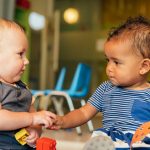
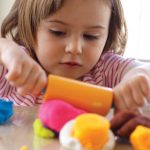
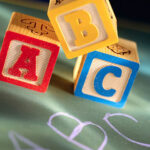
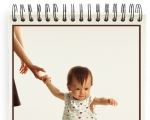
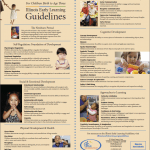
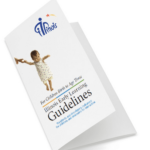

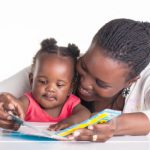
 Printer-friendly PDF
Printer-friendly PDF